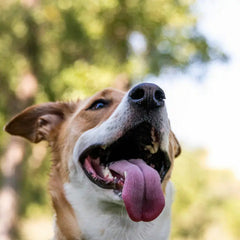In the hustle and bustle of daily life in the UK, it’s not uncommon for our faithful canine companions to experience separation anxiety when left alone. In this article, we delve deep into recognising the symptoms, exploring various training techniques, and introducing products and professional assistance that can aid in managing this condition effectively.
Recognising Symptoms
Understanding the signs of separation anxiety is the first step towards helping your dog cope with this condition. Here, we will uncover the common signs and delve into the nuances of this behavioural issue.
Physical Symptoms
- Excessive salivation
- Pacing
- Trembling
Behavioural Symptoms
- Barking and howling
- Chewing, digging, and destruction
- Escaping
Understanding the symptoms will equip you with the knowledge needed to approach this issue sensitively and effectively.
Training Techniques
Training is a pivotal aspect of managing separation anxiety in dogs. Below, we outline various techniques that can be implemented to ease your dog's anxiety.
Desensitisation
- Gradual Increments: Start with short absences, gradually increasing the time you spend away.
- Positive Association: Associate your departure with positive experiences such as treats or new toys.
Counterconditioning
- Focus on Calmness: Encourage calm behaviour by rewarding your dog when they are relaxed.
- Distraction: Provide engaging toys to distract them when you are away.
Training techniques require patience and consistency, and it is important to tailor the training to your dog’s individual needs.
Anti-Anxiety Products
In the market, there are a plethora of products available that can assist in reducing anxiety in dogs. Let’s explore some of the options.
Calming Diffusers
- Pheromone Diffusers: These release a synthetic version of the pheromones mother dogs emit to calm their puppies.
Anxiety Wraps
- Pressure: Anxiety wraps apply gentle pressure on the dog’s body, providing a calming effect.
Toys
- Interactive Toys: Toys that stimulate your dog’s mind can be a great distraction and can reduce anxiety.
Remember to choose products based on your dog’s preference and comfort.
Consulting a Behaviourist
In some cases, it may be beneficial to consult a professional behaviourist to manage your dog’s separation anxiety.
Finding a Behaviourist
- Referrals: Ask your vet for referrals to find a reputed behaviourist.
- Certifications: Ensure that the behaviourist has the necessary certifications and experience.
Behavioural Therapy
- Individualised Plan: A behaviourist can create a tailored plan to manage your dog’s anxiety.
- Follow-ups: Regular follow-ups can ensure that the plan is effectively reducing the symptoms of anxiety.
Seeking professional help can often be a step in the right direction, providing structured support in managing separation anxiety.
Pharmaceutical Aids
In severe cases, pharmaceutical aids may be prescribed as a part of the treatment plan.
Types of Medications
- Anxiolytics: Medications such as Diazepam can be prescribed to reduce anxiety.
- Antidepressants: In some cases, antidepressants may be prescribed.
Veterinary Consultation
- Diagnosis: A proper diagnosis by a vet is essential before starting any medication.
- Monitoring: Your vet will closely monitor your dog while they are on medication to ensure their safety.
It is essential to work closely with your vet to find the most appropriate pharmaceutical solution for your dog.
FAQs
Q: Can separation anxiety lead to other health issues?
A: Yes, prolonged anxiety can lead to a variety of health issues including digestive problems.
Q: Can puppies have separation anxiety?
A: Yes, puppies can experience separation anxiety, and it is often beneficial to start training early to prevent the development of severe separation anxiety as they grow.
Conclusion
Separation anxiety in dogs is a pressing issue faced by numerous dog owners in the UK. Recognising the symptoms early on and adopting appropriate training techniques can often help in managing this condition. Utilising anti-anxiety products and consulting a behaviourist can further aid in alleviating the symptoms. In severe cases, pharmaceutical aids might be necessary, and it is always recommended to work closely with a vet in such scenarios. By following this guide, you can work towards creating a calm and safe environment for your dog, promoting a happy and healthy life for your beloved pet.



